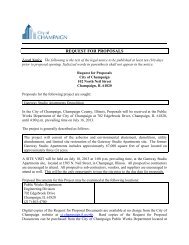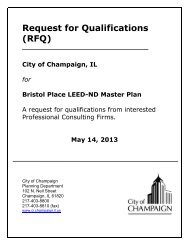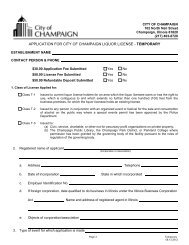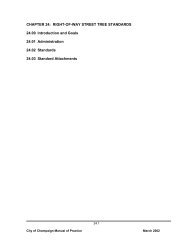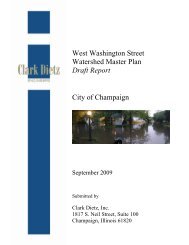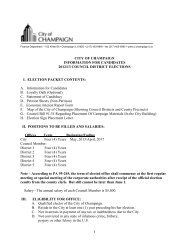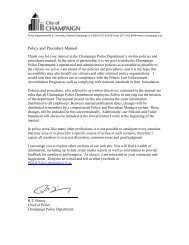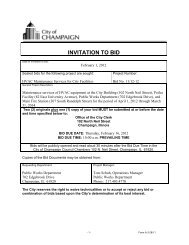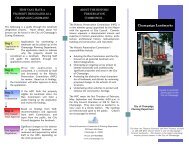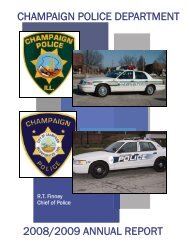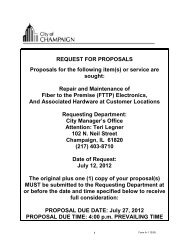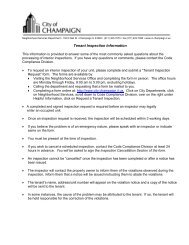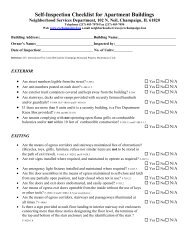oooooSpalding Park: waterline replacement (drinking fountain), pool repairs, bathhouse repairsBristol Park: fencingHazel Park: playground replacementDouglass Center: HVAC, perimeter fence/gateDouglass Annex: HVACHealth Care FacilitiesCommunity Health Improvement Center/Frances Nelson Health CenterThe mission <strong>of</strong> the Frances Nelson Health Center is to provide affordable and accessible, high qualitycomprehensive health care services to the medically underserved population <strong>of</strong> the <strong>Champaign</strong> Countyareas. The Center provides comprehensive primary health care services, including preventive services,immunizations, breast and cervical cancer screenings, diagnosis and treatment <strong>of</strong> acute and chronicdiseases, prenatal care, on-site lab services and referrals for specialty care. With the help <strong>of</strong> CDBGfunding from the Cities <strong>of</strong> <strong>Champaign</strong> and Urbana, FNHC relocated to a larger site at 819 BloomingtonRoad, <strong>Champaign</strong>, in 2006.<strong>Champaign</strong>-Urbana Public Health DistrictThe <strong>Champaign</strong>-Urbana Public Health District (CUPHD) was formed by referendum in 1937 to establishpublic health services for Cunningham Township (the <strong>City</strong> <strong>of</strong> Urbana) and the <strong>City</strong> <strong>of</strong> <strong>Champaign</strong>Township (the <strong>City</strong> <strong>of</strong> <strong>Champaign</strong>). Simply stated, the agency’s mission is “to improve the health <strong>of</strong> the<strong>Champaign</strong> County community.” This is achieved by preventing disease, injury and disability; promotinghealthy living; and providing early diagnosis <strong>of</strong> disease to improve health outcomes (and reduce healthcare costs). CUPHD provides a wide range <strong>of</strong> preventive health services for the entire community, e.g.,environmental health inspections <strong>of</strong> restaurants and grocery stores, vision & hearing screening forchildren in schools and pre-schools, health education, etc. CUPHD also provides the following preventiveprimary health care services predominantly to low-income clientele: pregnancy testing, prenatal casemanagement/support, WIC supplemental nutrition program, well baby check-ups, immunizations, schoolphysicals, dental services for children, Health Checks (which check blood pressure, blood cholesterol, andblood sugar levels), a Sexually-Transmitted Disease clinic, HIV and Hepatitis screening, “Wellness onWheels” mobile preventive health services, and more. CUPHD moved to its current location at 201 W.Kenyon Road, <strong>Champaign</strong> in 2007, allowing all services to be consolidated at one site.SECTION 4B: PUBLIC IMPROVEMENTSInfrastructureThe <strong>City</strong> <strong>of</strong> <strong>Champaign</strong> builds, maintains and rehabilitates ten infrastructure systems - alleys, bridges,parking, sanitary sewers, sidewalks, storm sewers and drainage, streetlights, streets, traffic signs andsignals, and urban forest. The <strong>City</strong> implemented standards for the development <strong>of</strong> new neighborhoods,where most <strong>of</strong> the basic infrastructure systems must be provided as a part <strong>of</strong> the new development.However, the older areas <strong>of</strong> the <strong>City</strong> which include many <strong>of</strong> the lower-income neighborhoods, may notmeet the <strong>City</strong>’s current standards.The quality <strong>of</strong> the <strong>City</strong>’s infrastructure systems contributes to the quality <strong>of</strong> life for residents in terms <strong>of</strong>appearance, health and safety. Failing systems, such as sanitary and storm sewers, can damageproperty and discourage residents from choosing to live in certain areas. Other systems, such assidewalks, alleys, and streets, can become an impediment for the elderly and persons with disabilities ifnot properly maintained. As neighborhoods age, infrastructure systems require greater effort and cost toimprove and repair.Needs Assessment: Non-Housing Community Development 55
Alley ConditionA majority <strong>of</strong> the <strong>City</strong>’s alleys are located within older neighborhoods. The more recently constructedneighborhoods are typically designed without a need for alleys. The following is a summary from theAlley Master <strong>Plan</strong>, approved by <strong>City</strong> Council in CB 2005-090 and available athttp://archive.ci.champaign.il.us/archive/dsweb/Get/Document-2699/CB%202005-090.pdfo The <strong>City</strong> has approximately 15.47 miles <strong>of</strong> alleys.o Alley composition consists <strong>of</strong> 5.21 miles <strong>of</strong> paved surfaces (asphalt, concrete, and brick), 7.7miles <strong>of</strong> asphalt millings, 1.5 miles <strong>of</strong> aggregate, and 1.06 miles grass.o Approximately 67% <strong>of</strong> the alley surfaces (10.63 miles) have a condition rating <strong>of</strong> either averageor above average.o Annually, the alley inventory is updated to reflect changes in the alley condition rating, surfacetype, and ownership.o Approximately 0.104 miles <strong>of</strong> paved alleys are rehabilitated annually.o Asphalt Section patches potholes in paved alleys (5.21 miles) requiring 300 staff hours and 20 to25 tons <strong>of</strong> asphalt each fiscal year. This Section also blades and patches potholes in milling alleys(7.7 miles) requiring 300 staff hours and 300 tons <strong>of</strong> asphalt millings.o Annually, the Street Section blades rock alleys (1.5 miles) requiring 250 staff hours and 500 tons<strong>of</strong> rock. This Section also completes debris and vegetation clean-up in the alleys requiring 200staff hours.o Public Works' staff works with other <strong>City</strong> departments to vacate alleys that are no longer needed.o The alley rehabilitation program for paved surfaces has a backlog <strong>of</strong> 1.72 miles. Availableresources allow 0.104 miles to be rehabilitated annually. Estimated time to complete currentbacklog is 16.5 years.o Unpaved alleys (3.2 miles) in high-density residential or commercial areas need to be brought upto “permanent improvement” standards. Current <strong>City</strong> Policy requires “permanent improvements”to be constructed with a cost-share <strong>of</strong> 75% private and 25% public. To date, the cost-sharepolicy has encouraged very few alleys to be improved to “permanent improvement” standards.Pavement ConditionThe following summary is available in the Pavement Master <strong>Plan</strong>, approved by <strong>City</strong> Council in CB 2006-204 and available at http://archive.ci.champaign.il.us/archive/dsweb/Get/Document-4234/CB%202006-204.pdf and the <strong>Plan</strong> itself is attached to the Study Session report athttp://archive.ci.champaign.il.us/archive/dsweb/Get/Document-4162/SS%202006-050.pdfThe Pavement Master <strong>Plan</strong> provides a comprehensive look at the <strong>City</strong>’s pavement system. The masterplan summarizes information on the type, amount, and condition <strong>of</strong> the <strong>City</strong>’s different pavements,current maintenance practices, annual contract street maintenance projects, and the criteria used indetermining work locations. The master plan also identifies areas that need improvement and providesrecommendations that will address those areas. The recommendations presented in the master planinclude:o Addressing inadequate arterial streets within the Transportation Master <strong>Plan</strong> since it is less apavement issue and more <strong>of</strong> a transportation planning issue.o Completing an analysis <strong>of</strong> engineering services separate from the Pavement Master <strong>Plan</strong>. A studywill be shared with Council later this year that will identify the optimal blend <strong>of</strong> engineering staffand consultants to provide design and construction engineering services for contract streetmaintenance projects.ooCreating and using a multi-year work plan generated by the pavement management system.Taking advantage <strong>of</strong> funding opportunities when they present themselves and applying the fundsto maintaining the pavement network.56 Needs Assessment: Non-Housing Community Development
- Page 1 and 2:
2010-2014Consolidated Plan2010/11 A
- Page 3:
This page intentionally left blank
- Page 11 and 12:
This page intentionally left blankv
- Page 13 and 14:
• Provide decent, affordable hous
- Page 15 and 16:
homeless populations. The City cont
- Page 17 and 18:
Summary of Citizen ParticipationDat
- Page 19 and 20: The City held three public hearings
- Page 21 and 22: Chapter 2Housing Market AnalysisCOM
- Page 23 and 24: compared to the remainder of the Ci
- Page 25 and 26: single parent households increased
- Page 27 and 28: Census. The U.S. Census Bureau esti
- Page 29 and 30: Table 2-1: Housing Opportunity Inde
- Page 31 and 32: All but three planning areas have h
- Page 33 and 34: Loan Denial Rates by Race and Incom
- Page 35 and 36: • Additional affordable or subsid
- Page 37 and 38: 2014 Consolidated Plan and will be
- Page 39 and 40: Because the cost of homeownership i
- Page 41 and 42: The City will renew its marketing e
- Page 43 and 44: of Champaign programs, are meeting
- Page 45 and 46: At incomes of
- Page 47 and 48: in the long-term. The City will con
- Page 49 and 50: from a disabling condition (usually
- Page 51 and 52: Almost all of the agencies that pro
- Page 53 and 54: monies to provide housing assistanc
- Page 55 and 56: Discharge Coordination PolicyContin
- Page 57 and 58: provide structural modifications an
- Page 59 and 60: Persons with Developmental Disabili
- Page 61 and 62: entering substance abuse treatment
- Page 63 and 64: RESTORATION OR REVITALIZATION NEEDS
- Page 65 and 66: licensed day care facility, nursery
- Page 67 and 68: portion of the workshop is devoted
- Page 69: • 27 playgrounds• 24 outdoor te
- Page 73 and 74: - lack of a multi-year schedule for
- Page 75 and 76: Redevelopment Initiatives - Commerc
- Page 77 and 78: Job TrainingThe Champaign Consortiu
- Page 79 and 80: improving their skills and career o
- Page 81 and 82: The development that occurred as a
- Page 83 and 84: organizations. The creation of the
- Page 85 and 86: non-profits (such as Habitat for Hu
- Page 87 and 88: Activities:1) Targeted Full Home Im
- Page 89 and 90: creation and preservation of afford
- Page 91 and 92: 4) Employer Assisted Housing: Explo
- Page 93 and 94: housing units are located. The City
- Page 95 and 96: successful. These supportive servic
- Page 97 and 98: 3) Accessible New Construction: Pro
- Page 99 and 100: 3) Prevention Education: Reduce the
- Page 101 and 102: Strategies:a) Maintain the safety a
- Page 103 and 104: ) Support programs that provide hig
- Page 105 and 106: Activities:1) Neighborhood Small Gr
- Page 107 and 108: The information collected through t
- Page 109 and 110: addressing blighted properties owne
- Page 111 and 112: Non-Housing Community Development A
- Page 113 and 114: America Saves is designed to reinfo
- Page 115 and 116: The Neighborhood Services Departmen
- Page 117 and 118: Homeowner Investment X NetHOME inve
- Page 119 and 120: impacts the housing market in terms
- Page 121 and 122:
FY 2010/11 AAP Chapter 3:Affordable
- Page 123 and 124:
) Improve the condition of rental p
- Page 125 and 126:
) Reduce other blighting influences
- Page 127 and 128:
with Champaign County Regional Plan
- Page 129 and 130:
Habitat for Humanity chapter to ide
- Page 131 and 132:
Inputs: $10,000 per lot is availabl
- Page 133 and 134:
service providers facilitate an eff
- Page 135 and 136:
make existing affordable units acce
- Page 137 and 138:
Objectives:a) Coordinate public and
- Page 139 and 140:
FY 2010/11 AAP Chapter 4:Non-Housin
- Page 141 and 142:
approximately 4,900 persons, over 5
- Page 143 and 144:
128 FY 2010/11 Annual Action Plan:
- Page 145 and 146:
Objectives:a) Support programs to e
- Page 147 and 148:
School Resource Officer Program: Fo
- Page 149 and 150:
associations registered with the Ci
- Page 151 and 152:
FY 2010/11 AAP Chapter 6:HUD CPMP P
- Page 153 and 154:
FY 2010/11 AAP Chapter 5:FY 2010/11
- Page 155 and 156:
L M HA c c o m p l . T y p e :I n c
- Page 157 and 158:
L M HA c c o m p l . T y p e :I m p
- Page 159 and 160:
L M HA c c o m p l . T y p e :I n c
- Page 161 and 162:
L M HA c c o m p l . T y p e :I m p
- Page 163 and 164:
L M HA c c o m p l . T y p e :I n c
- Page 165 and 166:
L M CA c c o m p l . T y p e :I m p
- Page 167 and 168:
N o t A p p l i c a b l eA c c o m
- Page 180 and 181:
Appendix AConsultation/Participatio
- Page 182 and 183:
Appendix B 167
- Page 184 and 185:
• Clear floor space (18” minimu
- Page 186 and 187:
Laundry Areas• Front loading wash
- Page 188 and 189:
Appendix DCity Approved Visitabilit
- Page 190 and 191:
Exception: This does not apply to p
- Page 192 and 193:
Cost Burden, Extreme (or Severe): T
- Page 194 and 195:
friction surfaces, or impact servic
- Page 196 and 197:
SRO: Single-Room Occupancy.Subsidiz
- Page 198 and 199:
Appendix FCitizen Participation Pla
- Page 200 and 201:
E. PUBLIC HEARINGSDuring the Consol
- Page 202 and 203:
- Submission of objections within 3
- Page 204 and 205:
-- The development of the Consolida
- Page 206 and 207:
Neighborhood Services DepartmentNei
- Page 208 and 209:
Kerri stated it needs to be under c
- Page 210 and 211:
longer be considered a pilot progra
- Page 212 and 213:
CHAMPAIGN CITY COUNCILRegular Counc
- Page 214 and 215:
AUDIENCE PARTICIPATION:Firefighter
- Page 216 and 217:
Appendix HAnti-DisplacementFOR Comm
- Page 218 and 219:
SECTION ISTEPS TO BE TAKEN TO MINIM
- Page 220 and 221:
SECTION IISTEPS TO BE TAKEN WHEN LO
- Page 222 and 223:
moderate income households that are
- Page 224 and 225:
SECTION IIISTEPS TO BE TAKEN WHEN C
- Page 226 and 227:
1. The lessor of the monthly cost o
- Page 228 and 229:
displacement, stating who will be r
- Page 230 and 231:
funding the project, or the displac
- Page 232 and 233:
Appendix AGLOSSARY OF TERMSBelow ar
- Page 234 and 235:
project is subject to the Uniform A
- Page 236 and 237:
Appendix BAPPEALSThe City of Champa
- Page 238 and 239:
Appendix COne for One Replacement P
- Page 240 and 241:
Appendix IHUD CPMP Needs Worksheets
- Page 242 and 243:
Table 1BSpecial Needs (Non-Homeless
- Page 244 and 245:
Table 2APriority Housing Needs/Inve
- Page 246 and 247:
Table 2BPriority NeedAcquisition of
- Page 248 and 249:
Housing Inventory Chart: Emergency
- Page 250 and 251:
Housing Inventory Chart: Safe Haven
- Page 252:
Housing Inventory Chart: Unmet Need



